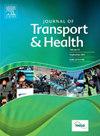Who’s still riding? Subgroup analysis of bicycling in the US
IF 3.2
3区 工程技术
Q2 PUBLIC, ENVIRONMENTAL & OCCUPATIONAL HEALTH
引用次数: 0
Abstract
Introduction:
Bicycling is a healthy and sustainable mode of transportation that offers benefits such as improved physical and mental health, reduced environmental impact, and cost-effective mobility. It alleviates traffic congestion, lowers greenhouse gas emissions, and fosters an active lifestyle, making it crucial for urban planning and public health. This paper explores bicycling trends, focusing on sex, sociodemographic characteristics, and COVID-19 impacts using National Household Travel Survey (NHTS) data from 2017 and 2022.
Methods:
NHTS datasets were analyzed to examine bicycling patterns across various sociodemographic groups, including sex, income, race, urban vs. rural location, and educational attainment. A subgroup analysis looked at bicycling participation by sex and between White and BIPOC groups. The study also investigated the effects of the COVID-19 pandemic on bicycling trends across the sexes, considering changes in travel behavior, work patterns, and home delivery usage.
Results:
Males reported higher bicycling rates than females, but the gap narrowed slightly over time. Bicycling increased among higher-income groups, Asians, and Native Hawaiians or Pacific Islanders. Urban areas showed higher rates than rural ones, and higher educational attainment correlated with more bicycling. The pandemic significantly altered travel behavior, with less work-related travel associated with increased bicycling for both sexes and home delivery usage linked to more cycling. Despite a rise in cycling among females due to pandemic changes, sex-related disparities persisted. There was also a notable increase in interest among older adults in 2022.
Conclusions:
The findings underscore the need for targeted interventions to promote equitable bicycling practices and capitalize on pandemic-induced shifts to boost active transportation and public health. Reducing sex-related disparities and encouraging broader participation could enhance bicycling’s contribution to public health and sustainability.
谁还在骑马?美国骑自行车的亚群分析
简介:骑自行车是一种健康和可持续的交通方式,它提供的好处包括改善身心健康,减少对环境的影响,以及具有成本效益的机动性。它缓解了交通拥堵,降低了温室气体排放,促进了积极的生活方式,对城市规划和公共卫生至关重要。本文利用2017年至2022年的全国家庭旅行调查(NHTS)数据,探讨了骑自行车的趋势,重点关注性别、社会人口特征和COVID-19的影响。方法:对NHTS数据集进行分析,以检查不同社会人口群体的骑自行车模式,包括性别、收入、种族、城市与农村位置和受教育程度。一项亚组分析研究了按性别、白人组和BIPOC组之间的自行车参与情况。该研究还调查了COVID-19大流行对两性骑自行车趋势的影响,考虑到旅行行为、工作模式和送货到家使用的变化。结果:男性报告的骑车率高于女性,但随着时间的推移,差距略有缩小。在高收入群体、亚洲人、夏威夷原住民或太平洋岛民中,骑自行车的人数有所增加。城市地区的骑自行车率高于农村地区,而且受教育程度越高,骑自行车的人越多。大流行显著改变了出行行为,与工作相关的出行减少与男女骑自行车的人数增加有关,而送货上门与骑自行车的人数增加有关。尽管由于流行病的变化,女性骑自行车的人数有所增加,但与性别有关的差距仍然存在。2022年,老年人的兴趣也显著增加。结论:研究结果强调需要有针对性的干预措施,以促进公平的骑自行车做法,并利用大流行引起的转变,促进主动交通和公共卫生。减少与性别有关的不平等并鼓励更广泛的参与,可以加强骑自行车对公共健康和可持续性的贡献。
本文章由计算机程序翻译,如有差异,请以英文原文为准。
求助全文
约1分钟内获得全文
求助全文

 求助内容:
求助内容: 应助结果提醒方式:
应助结果提醒方式:


